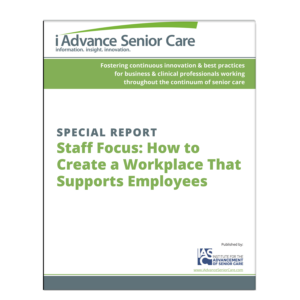Lessons Learned in Creating a Successful CNA Retention Program
| In Creating a Successful CNA Retention Program |
| By Richard Hoffman |
| One organization’s solution to the problem of turnover For some time now, nursing homes have been staggering under the high cost of turnover, especially among CNAs. Ironically, this is one of the few costs that can be controlled in today’s regulatory environment. One recent study placed the cost of recruiting and training at $4,000 per new CNA. Combine that figure with a nationwide CNA turnover rate of 93%, and you’re talking a major financial burden on the industry as a whole. While providers agree that CNA retention is critical to both fiscal health and the quality of care residents receive, few can agree on what an effective retention program includes and how it can be successfully implemented. Recently, one large provider, Integrated Health Systems, along with curriculum specialists at Frontline Publishing, decided to make retention their first priority. The program they developed, IHS CareWorks, resulted in a savings of $14 million during a nine-month period, even before complete corporate implementation of the program. In planning IHS CareWorks, Frontline and IHS focused on developing programs to keep CNAs through the first 90 days and to construct a clear career path for them to follow in the coming months and years. Rooted in an industry-wide study of best practices, IHS CareWorks addresses orientation, mentoring, career growth, recognition, supervision and compensation in an integrated and comprehensive attempt to thoroughly transform the entire work life of the nursing assistant.Several valuable lessons can be gleaned from Integrated’s successful launch of IHS CareWorks. Lesson #1: Know what turnover is costing you. Believe it or not, there are providers-both individual facilities and larger organizations-that neglect to measure the cost of their turnover. A full understanding of turnover’s financial consequences is sometimes just the shock a provider needs to fully commit to a retention program. Knowing the cost of your turnover also provides a benchmark for cost-benefit analysis, since a retention program, like any major problem-solving initiative, costs money. The first step for IHS was a detailed analysis of what their turnover rate was costing them annually across the organization. Lesson #2: You must have buy-in from the top. Whether you are a single facility or a larger organization, without buy-in from the top-and enthusiastic buy-in, at that-any changes needed will meet with resistance. Most people find change threatening. Unless top management makes it clear that this is company policy and not merely a shift in rhetoric, most people will go on with “business as usual,” which will weaken and devalue your program. Lesson #3: Offer salary increases to CNAs who participate. Skeptics who doubt the impact pay increases will have are at least partly right: Increased compensation by itself will not slow turnover. Increased compensation tied to professional development, however, is a one-two combination that has again and again proven effective in bringing attrition down. The aim of a retention program is not only to keep CNAs on the job, but also to make them the best caregivers they can be. Salary increases based upon participation in career ladder and mentoring programs provide your CNAs with a tangible demonstration of your gratitude and respect. So as your staff gains in knowledge and skills, acknowledge their growth appropriately-in their pay envelopes. Lesson #4: You need a champion. Memos won’t do it. Announcements on bulletin boards won’t do it. You need an evangelist, an apostle who believes in the program wholly and will work to create and maintain enthusiasm. This person is a trainer (generally training those who will administer the program’s various components in their facilities), a trouble-shooter, a coach, an indefatigable advocate for change.This champion must be equally comfortable with top-level management and frontline staff. To be effective, this advocate must be credible and approachable by staff, and he or she must be given the time and resources to make implementation of the program top priority. IHS’s Director of Training Paul Wray is well suited to this role, having been a CNA, an LPN, an RN, a staff development coordinator, a DON and an administrator (see profile). Charged with the implementation of IHS CareWorks, Wray logged thousands of miles piloting the various curricula and training staff development coordinators to implement the program at the facility level. “I believe in this program. I guess I’m a bit of an evangelist,” he says. Lesson #5: Reinforce the value of the program by publicly recognizing the achievements of participants. Committing yourself to developing a comprehensive program means reinventing the work environment to rejuvenate a demoralized workforce. Nothing succeeds in building morale like recognition for real achievements.At IHS, graduates of The IHS Care-Works Career Growth program were given a new job title, Caregiver I, and an hourly increase in pay. People who had been used to seeing their jobs as dead-end began to see a career path stretching out ahead. People who had felt overlooked now felt that they were respected members of the caregiving team. Graduation programs, replete with cap and gown, music, speeches and dinner celebrated the educational achievement of the participants. The ceremonies were written up in the local press, providing the facilities with positive publicity and contributing to recruitment efforts.According to CNA Burnice Husband, “It helped me deal with the type of patients we have. They made the class fun, and that was good. It made me proud to be a CNA.” Lesson #6: Track your success. As you begin to harvest the fruits of your efforts and see (and feel!) the changes in the atmosphere, look to the numbers. Track the effectiveness of your program in real dollars saved. How many CNAs more than last year do you need to keep, in order to pay for the cost of the program? For example, if you spend $24,000 on a retention campaign and you stop six CNAs from leaving over the course of a year, you’ve paid yourself back. The rest is gravy! Or, more accurately, the rest is your money that had previously been wasted on Band-Aid approaches to the problem. Lesson #7: Focus on your future staffing needs, starting with new hires. Much of the costly turnover that takes place in healthcare facilities occurs in the first 90 days. The solution to this aspect of the problem lay in the development of another IHS CareWorks component, The BRIDGE Mentoring Program-a set of corporate standards for identifying, training and rewarding experienced CNAs who are committed to helping new caregivers learn the ropes.The value of a peer-mentoring program lasts long after the initial weeks of a CNA’s employment. Besides helping to retain new staff, a good mentoring program orients them to the expectations of the best of their peers and serves to cultivate the kind of teamwork and cohesiveness that results in quality care. It also helps them to be productive contributors sooner, and they see right from the start that their success is important both to their employer and their coworkers. Lesson #8: Don’t stop innovating. Keeping the real goal in mind-to create stability and rejuvenate your frontline staff-you will find that one initiative suggests another. As you develop ways to transform the work life of your staff, you might find that it makes sense to use some of the savings realized to develop a second tier of educational achievement, as IHS and Frontline did in devising IHS Caregiver II, which has now graduated several classes. Or you might wish to put similar professional development programs in place to enhance supervision or provide tuition reimbursement for your very best CNAs who would like to study nursing. When the word gets out that you are offering people not merely a job but a career path, you not only retain existing employees, but you also attract the kind of recruits who are interested in making a long-term commitment. The point is that you are not trying to staff your facility just for today, but for years to come. “It’s actually fairly simple,” says IHS Human Resources SVP Jeanne Phillips. She explains, “Employees who are adequately trained, recognized and confident of their ability to handle the demands of their work stay on the job for far longer.” NH Richard Hoffman is senior editor and consultant, Frontline Publishing. |
I Advance Senior Care is the industry-leading source for practical, in-depth, business-building, and resident care information for owners, executives, administrators, and directors of nursing at assisted living communities, skilled nursing facilities, post-acute facilities, and continuing care retirement communities. The I Advance Senior Care editorial team and industry experts provide market analysis, strategic direction, policy commentary, clinical best-practices, business management, and technology breakthroughs.
I Advance Senior Care is part of the Institute for the Advancement of Senior Care and published by Plain-English Health Care.
Related Articles
Topics: Articles , Staffing











